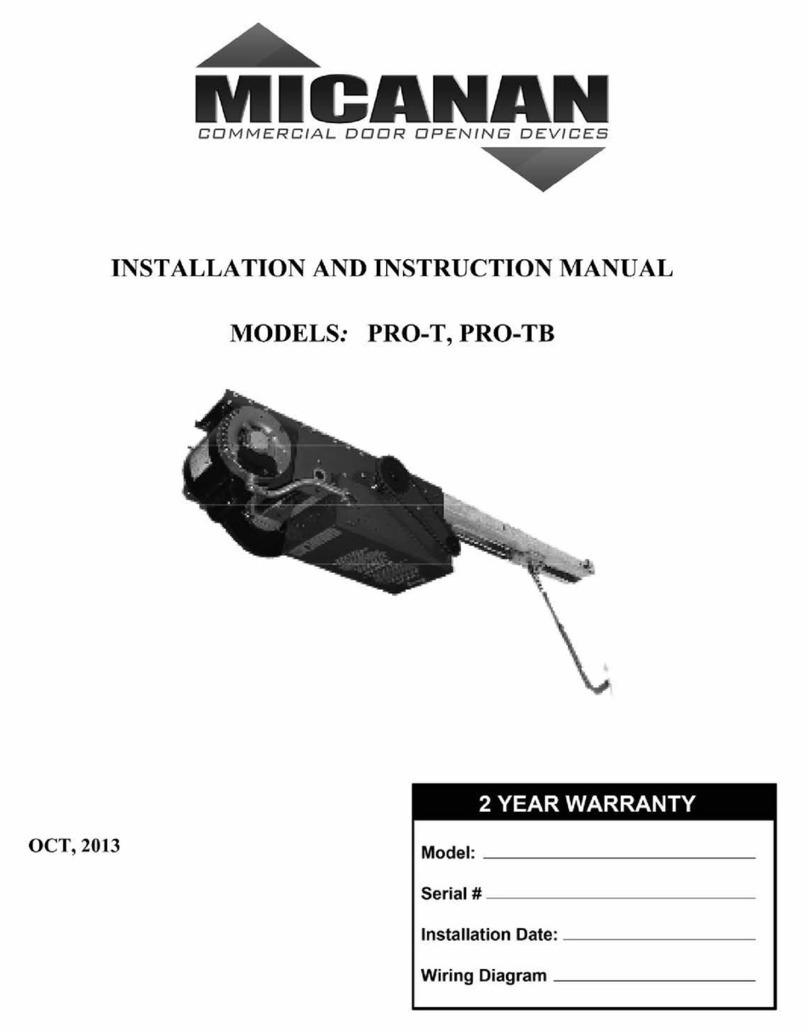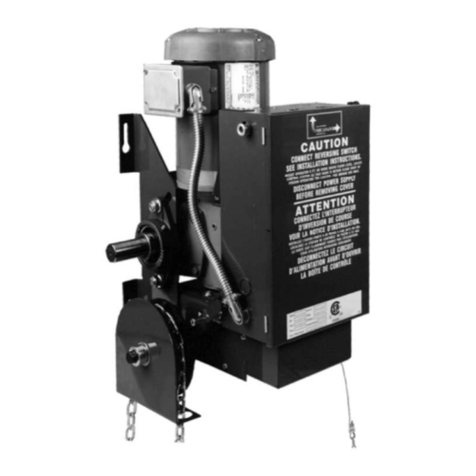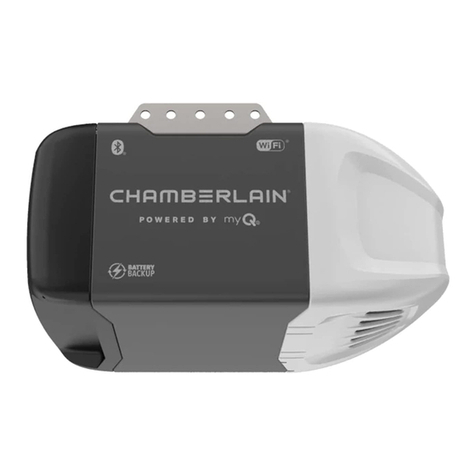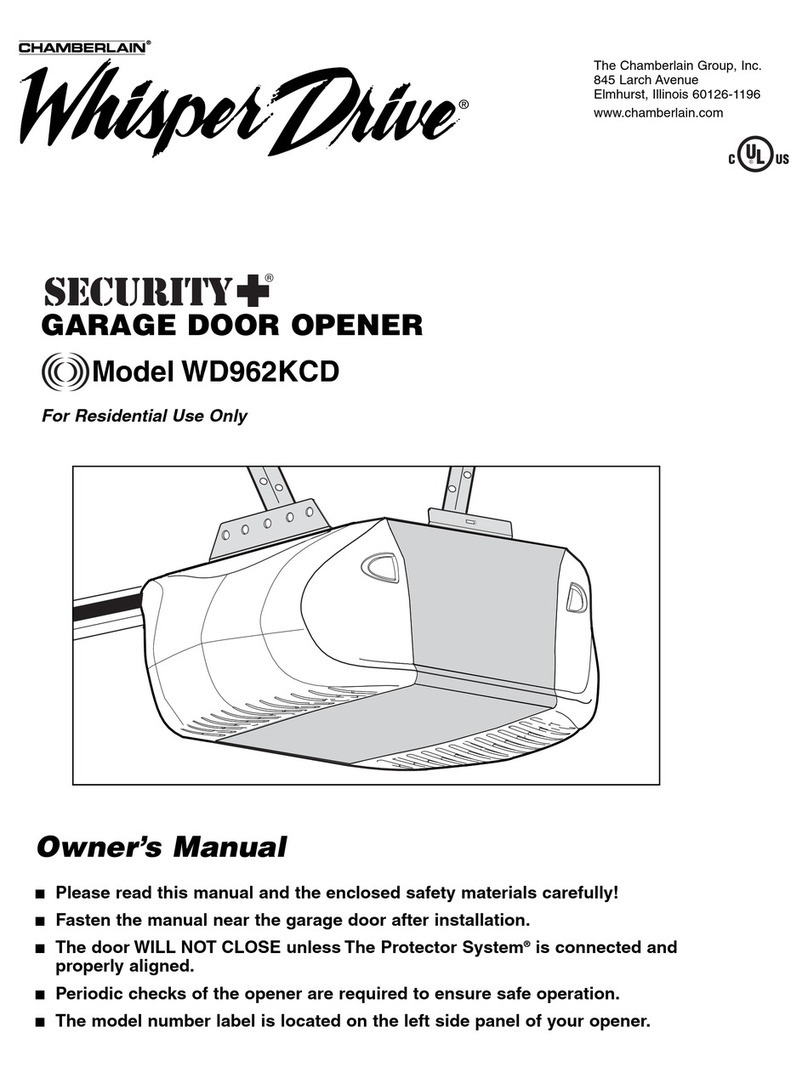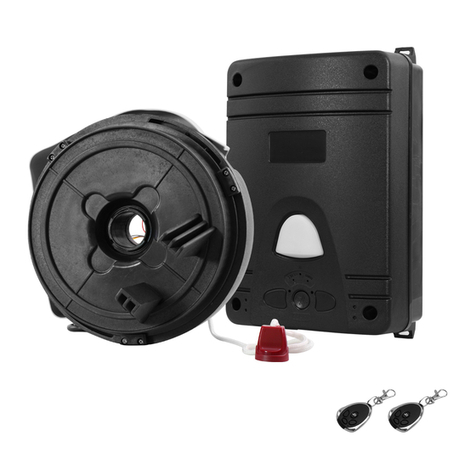Micanan PRO-LH Service manual

For more information, please visit www.devancocanada.com or call toll free at 855-931-3334


3
Upon delivery of your MICANAN SYSTEMS medium-duty jackshaft door operator, please inspect the unit carefully for
damage. Verify that operator horsepower, voltage, phase and amperage correspond to available power supply and door
application. Check that along with your operator you have received the following standard hardware.
1x OPEN/CLOSE/STOP 3-button control station:
1 x #41 Drive chain package : 4’ (1.2m) c/w #41 connecting link
1 x Drive Sprocket 41B12 x 1” c/w 2 set screws and ¼” x 1-1/4” keyway
1 x Door Sprocket 41B32 x 1” c/w 2 set screws and ¼” x 1-1/4” keyway
Note: Sprocket size and bore may vary according to
door size and type, shaft size and drum diameter
1 x Chain keeper
1 x Keyring
4 x 3/8” bolt, hex nut, lock washer and flat washer
1 x pocket wheel hand chain (Model PRO-LH) (2 x door height less 4’ (1.2m))
1 x Warning sign
1 set of Micanan photocells (supplied when operator ordered
with interface module or logic board controls)
VERIFICATION OF OPERATOR AND HARDWARE

4
PRO-LJ and PRO-LH medium duty jackshaft operators are designed for commercial high lift, vertical lift, rolling doors and
rolling grilles provided that doors are driven by a drive shaft with low duty cycles. Model PRO-LH is essentially the same as
model PRO-LJ with the exception that the PRO-LH operator incorporates a chain hoist for manual operation of the door.
STANDARD OPERATOR WEIGHT: 45-50 LBS
MOTOR: Intermittent duty 1000 RPM motor with high starting torque.
- Thermally protected by a built-in thermostat that cuts power to the motor and control circuit when overheating.
- Horsepower: 1/2HP - Voltage: 115V 1-phase (60Hz) 220V 1-phase (50Hz)
230V 1-phase (60Hz) 380V 3-phase (50Hz)
REDUCTION: Primary: (4L) V-belt and pulleys (1.5” to 7” diameter), Secondary: #41 chain and sprockets
OUTPUT SHAFT SPEED: 58 RPM
BRAKE : Solenoid actuated drum and brake shoe braking system to prevent coasting and maintain door position.
WIRING TYPE (3 OPTIONS):
Option 1: Limited Duty logic board Smart 5.0 (UL325 (2010) compliant). Note: Micanan compatible primary entrapment
device must be connected for B2 or TS (momentary or timer activation on close) feature.
Option 2: Relay logic controls with Interface Module (UL325 (2010) compliant). C2 Standard factory wiring (constant
pressure on close, momentary contact on open and stop). If momentary contact on close (B2) wiring is desired, connect
loose “purple” wire to terminal #5. Note: Micanan compatible primary entrapment device must be connected for B2
(momentary activation on close) feature.
Option 3: Standard relay logic controls (not UL325 (2010 compliant, not available in US) C-2 Wiring constant
pressure on close, momentary contact on open and stop. NOTE: If momentary contact on close (B2) wiring is desired,
connect loose “purple” wire to terminal #5.
TRANSFORMER: 24VAC control circuit, supplies power to drive control relays with 15VA power available for external
devices.
LIMIT ADJUSTMENT: 4 micro switches that control door travel. These limit switches are activated by fully adjustable screw
type cams.
EMERGENCY DISCONNECT: Floor level cable disconnect system with electrical cut-out feature allows person to manually
operate the door by hand (PRO-LJ) or by chain hoist (PRO-LH) in case of emergency.
CLUTCH: Adjustable friction clutch to minimize damage to door operator, door or vehicles when obstruction occurs.
OPERATOR DIMENSIONS:
PRO-LJ, PRO-LH SPECIFICATIONS
IMPORTANT NOTE
THIS MEDIUM DUTY OPERATOR IS DESIGNED TO OPERATE
A MAXIMUM OF 15 COMPLETE CYCLES PER HOUR.

5
-READ AND FOLLOW ALL INSTRUCTIONS
-Never allow children to operate or play with door controls. Keep the remote control (where provided) away from children.
-Personnel should keep away from a door in motion and keep the moving door in sight until it is completely closed or
opened. NO ONE SHOULD CROSS THE PATH OF A MOVING DOOR.
-Test the door’s safety features at least once a month. After adjusting the limit of travel, retest the door operator’s safety
features. Failure to adjust the operator properly may cause severe injury or death.
-For products having a manual release, if possible, use the manual release only when the door is closed. Use caution when
using this release when the door is open. Weak or broken springs may cause the door to fall rapidly, causing severe injury
or death.
-KEEP DOORS PROPERLY OPERATING AND BALANCED. See Door Manufacturer’s Owner’s Manual. An improperly
operating or balanced door could cause severe injury or death. Have trained door systems technician make repairs to cables,
spring assemblies, and other hardware.
-Press the “OPEN” device or use emergency disconnect mechanism if a person is trapped under the door.
-SAVE THESE INSTRUCTIONS. The owner or users must understand the safety and operation of door system. Insure
that this installation manual be located close to the door system.
-READ AND FOLLOW ALL INSTALLATION INSTRUCTIONS
-Commercial door operators are never to be installed on a residential installation
-Install only on a properly operating and balanced door. A door that is operating improperly could cause severe injury. Have
qualified service personnel make repairs to cables, spring assemblies, and other hardware before installing the operator.
-Remove all pull ropes and remove, or make inoperative, all locks (unless mechanically and/or electrically interlocked to the
power unit) that are connected to the door before installing the operator.
-Install the door operator at least 8 feet or more above the floor if the operator has exposed moving parts.
-Do not connect the operator to the source of power until instructed to do so.
-Locate the control station: (a) within sight of the door, (b) at a minimum height of 5 feet so that small children cannot reach
it, and (c) away from all moving parts of the door.
-Install the Entrapment Warning Placard next to the control station in a prominent location.
-For products having a manual release, instruct the end user on the operation of the manual release.
-Install non-contact entrapment protection devices (photocells) and/or contact entrapment protection devices (reversing
edges). Note: photocells should be installed at no more than 6” from the floor. Edges should be installed on the leading edge
of the door.
IMPORTANT INSTALLATION INSTRUCTIONS
IMPORTANT SAFETY INSTRUCTIONS
WARNING
TO REDUCE THE RISK OF INJURY OR DEATH:

6
Note: - Installation of operator must be done by a qualified installer. Door must be properly installed and working
smoothly. Remove all door locks prior to installation.
- The PRO-LJ and PRO-LH operators have dual output shafts and may be mounted on left (standard) or right hand
side of door. If handing of operator must be reversed, loosen set screws, remove drive sprocket and keyway and
install on opposite side of drive shaft.
- For the PRO-LH operator which incorporates a chain hoist mechanism the handing of the operator must be stated at
time of order. Depending on installation, if handing of chain hoist is not correct the hand chain may hang in door
opening. If this is the case, swing chain off to the side and hook it over the top of the door jamb. Do not attempt to
reverse chain hoist on site.
1. Install control station away from all moving door parts, within sight of the door and a minimum of 5 ft (1.5 m) from the
ground.
2. Install entrapment warning sign next to control station.
INSTALLATION INSTRUCTIONS
WARNING
DO NOT INSTALL THIS OPERATOR
BEFORE READING THIS MANUAL CAREFULLY.

7
3. As a general rule, the door operator should be installed below the drive shaft and as close to the door as possible. The
ideal distance between the operator drive shaft and the door shaft is approximately 12” (30cm) to 15” (38cm). The
operator may be wall/bench mounted or bracket /shelf mounted. These two mounting configurations are shown below:
4. Mount the operator to the wall, hood or bench with 3/8” bolts, nuts and washers provided or with lag bolts and shields
if installation requires it. Make sure that operator is secured but do not tighten bolts.
5. Place door sprocket on door shaft and align with operator drive sprocket but do not insert keyway or set screws.
6. If an optional chain spreader has been ordered with your operator, install as shown below:
7. Install drive chain over sprockets, cut to a suitable length and connect with connecting link.
8. Lower or raise operator to adjust chain tension so that there is no more than ¼” chain slack between sprockets. Tighten
operator mounting bolts.
9. Carefully re-align sprockets, if necessary and secure keyway and set screws.
10. (For the PRO-LH model) Install hand chain by wrapping it through chain guard holes and pocket wheel. Allow chain
to hang down towards floor. Cut chain and connect so that chain is 2’ to 3’ from the floor.

8
11. Install chain keeper to wall near hand chain at approximately 4’ from floor. Run disconnect chain through keyhole of
chain keeper and cut excess chain links if required. Attach keyring to end of disconnect chain.
12. If an optional floor level disconnect lever was ordered in lieu of the chain keeper, mount to wall with suitable
hardware. Attach both chains together using keyring provided. Allow disconnect chain to be slightly slack when lever
is in the up position.

9
THERE ARE 3 POSSIBLE ELECTRICAL CONTROL CONFIGURATIONS FOR THIS OPERATOR:
A) Standard relay logic controls (not UL325 (2010) compliant, not available in US). Refer to Section A for electrical
connections. Refer to electrical drawings inside your operator control box or generic drawings MSLHR-WW,
MSLH2-WW or MS300LH-WW in the electrical drawings section at the end of this manual.
B) Relay logic controls with Interface Module (UL325 (2010) compliant. Refer to Section B for electrical
connections. Refer to electrical drawings inside your operator control box or generic drawings MSLHR-IM-WW or
MSLH2-IM-WW or MS300LH-IM-WW in the electrical drawings section at the end of this manual.
C) Limited duty logic board Smart 5.0 (UL325 (2010) compliant). Refer to Section C for electrical
Connections and logic board instructions. Refer to electrical drawings inside your operator control box or generic
drawings MSLLHR-WW or MSLLHR220-WW, in the electrical drawings section at the end of this manual.
Refer to electrical diagrams inside control box cover or at the end of this manual prior to connection of power supply or control
station.
WARNING
TO REDUCE THE RISK OF INJURY OR DEATH:
ALL ELECTRICAL CONNECTIONS SHOULD BE MADE BY A QUALIFIED SERVICE PERSON
DO NOT ATTEMPT TO MAKE ELECTRICAL CONNECTIONS TO OPERATOR UNLESS
POWER SUPPLY HAS BEEN DISCONNECTED AT FUSE BOX
OPERATOR MUST BE CONNECTED IN ACCORDANCE TO LOCAL ELECTRICAL CODES
AND GROUNDED TO GREEN GROUND LUG LOCATED INSIDE CONTROL BOX
WARNING
COMPARE AVAILABLE POWER SUPPLY VOLTAGE TO OPERATOR NAMEPLATE PRIOR
TO ELECTRICAL CONNECTION. FAILURE TO CONNECT APPROPRIATE POWER SUPPLY
VOLTAGE MAY CAUSE SERIOUS DAMAGE TO OPERATOR.
ELECTRICAL CONNECTIONS
IMPORTANT
-MICANAN HIGHLY RECOMMENDS THAT EACH INDIVIDUAL COMMERCIAL
DOOR OPERATOR HAVE IT’S OWN DEDICATED POWER SUPPLY
-MICANAN HIGHLY RECOMMENDS THAT EACH INDIVIDUAL COMMERCIAL
DOOR OPERATOR HAVE AN EXTERNAL CIRCUIT BREAKER OR FUSED
DISCONNECT

10
SECTION A:PRO-LJ, PRO-LH Standard relay logic controls (not UL325
(2010) compliant, not available in US)
POWER WIRING: Use 1-1/8” (2.85 cm) diameter holes for all power wiring.
1. Single phase: Connect single phase power supply to terminals L/L1 (line) and N/L2 on three-pole
power terminal strip.
2. Three-phase (for 1/2HP 380V 50Hz): Connect three phase power supply to terminals L1, L2 and L3 on three-pole power
terminal strip.
CONTROL WIRING: Use 7/8” (2.22 cm) diameter holes for all control wiring.
Note: Do not run control wires and power wires in same conduit.
- Install control station within clear sight of door but away from all moving parts of door or hardware.
Install Entrapment warning sign next to control station. Connect 3-button (open/close/stop) push button
station to terminals 2, 3, 4 and 5. Refer to electrical diagram for connection of two 3-button stations.
NOTE: After electrical connections are made, manually move door to mid-position and, using the control station press the
“Open” button for several seconds and then press the “Stop” button. If door did not move in correct direction verify wiring
control station. For 3-phase (380V 50Hz) operators, if door still moves in wrong direction reverse any two of the three
incoming power supply leads to correct rotation.
- Adjust Limit switches as explained in the “Limit switch adjustment section” further in this manual.
CONNECTION OF POWER SUPPLY AND CONTROL STATION
LIMIT SWITCH ADJUSTMENT

11
1. Reversing Edge device (must be normally open contact):
Note: If the door is controlled by any device or wired in such a manner that the door is not controlled by constant
pressure on close then an appropriate reversing edge must be installed.
2. External interlock: Remove jumper between terminals 1 and 2 and wire a N.C. interlock contact between these two
terminals.
3. Radio control receiver: Wire standard radio receiver to separate radio strip on side of control box or to terminals 7, 8 and 9
on control terminal strip inside control box.
4. Single button open/close device: Wire to terminals 7 and 8 on control terminal strip.
5. Loop detectors, standard photocells (with a N.O. contact) and other reversing devices: Wire to terminals 3 and 6 on
control terminal strip.
6. 24 Volt power: Wire to terminals 1 and 9 on control terminal strip
CONNECTION OF A REVERSING EDGE DEVICE AND CONTROL ACCESSORIES

12
SECTION B:PRO-LJ(M), PRO-LH(M) Relay logic controls with Interface
Module (UL325 (2010) compliant)
Operator electrical connections and start-up instructions
Important: Follow these steps carefully and in the order shown
1) Connect Power supply:
Single phase: Connect single phase power supply to terminals L/L1 and N/L2 on the 3-pole power terminals strip.
3-phase (380V 50Hz): Connect 3-phase power supply to terminals L1, L2 and L3 on the 3-pole power terminal strip.
2) Connect Push-button station for installation purposes (single phase or 3-phase):
Connect open/close/stop push button station to terminals T2 (stop), T3 (common), T4 (open) and T6 (temporary CP on close).
3) Verify motor direction:
After the electrical power connections are made and push button station is connected, manually move the door to mid-position.
Press Close button for several seconds and then press stop button. If door did not move in correct direction (or if limit cams not
moving in correct direction towards the close limit switch) see below:
Single phase operators:The operators leave the factory with correct motor and limit shaft direction according to standard door
installations. However, for special fire door, thru- wall mounting or other special door applications, the motor direction and
limit switch direction may need to be reversed. To reverse the motor rotation, interchange Red and Yellow wires on the motor
capacitor located in the control box.
NOTE: THIS OPERATOR COMES WITH AN INTERFACE MODULE INTEGRATED INTO THE
CONTROL CIRCUIT. THE PURPOSE OF THE INTERFACE MODULE IS TO ALLOW FOR
FAILSAFE MONITORING OF A MICANAN COMPATIBLE SAFETY DEVICE AS PER UL 325 (2010)
REQUIREMENTS.

13
3-phase operators (1/2 HP 380V 50Hz): If door moves in wrong direction, turn off incoming power and reverse any two of the
three incoming power supply leads to correct rotation. Press the open button and then activate the open limit to ensure door
stops. If door does not stop, interchange grey and red wires on open and close limits. Interchange white and grey wires on
advanced open and advanced close limits. Remove blue wire from advanced open limit and place it on N.O pin of advanced
close limit.
4) Adjust limit switch cams:
Using the open/close/stop push button station move door to fully closed and fully open oppositions and set limit cams to correct
position. (See Limit adjustment section C further in this manual for complete detail on the end of travel limit adjustments).
5) Activate Interface module:
After adjusting the open and close limits and verifying the motor rotation, open the door to the full-open position using the open
push button (Figure below on left).
At this point the close pushbutton wire must now be moved from terminal T6 to T5. Now connect the black wire (with blue
label) to terminal T1 as shown in figure below on right.
Note: Ensure the door is in the full open position before connecting the black wire. If door is not in full open position and
monitored photo-eyes or safety edge are not connected and operational then door will immediately move in the open
direction.

14
6) Connect safety devices
Failsafe feature: A monitored failsafe safety feature is built into the operator. The operator has provisions to connect one
primary monitored safety device as well as one or more non-monitored safety device(s).
Primary monitored safety device:
MICANAN monitored failsafe photo beams or MICANAN compatible monitored failsafe devices must be connected to
terminals P1 and P2 if momentary close on pushbutton is required (B2 mode). If not connected, door can only be closed by
constant pressure on close pushbutton. If constant pressure on close pushbutton is removed before door reaches full closed
position, then door reverses to full open.
Note: Only one monitored failsafe safety device can be connected across terminals P1 and P2.
Note: See section E for complete installation instructions for the Micanan N-1 or N-4 photocells or the FRABA photocells.
Secondary non-monitored safety device(s):
A standard 2-wire safety edge, non-monitored reflective or thru-beam photo eye or any other non-monitored reversing devices
with a N.O dry contact can be connected to terminals S1 and S2.
Note: More than one secondary non-monitored safety device can be connected to terminals S1 and S2.
Important: Do not remove resistor that is factory installed across terminals S1 and S2 unless installing a 4-wire electric edge.
4-wire electric edge Connection
A standard 4-wire electric edge can be connected across S1 and S2 terminals as a secondary safety device. Remove the factory
installed resistor across terminals S1 and S2 and install resistor across the black and white pair of wires from the electric edge
and connect the remaining black and white wire to the S1 and S2 terminals.
7) Select Mode of Operation:
C2 mode of operation (momentary on open, constant pressure on close):
The operator is wired at the factory for momentary on open and constant pressure on close. For single phase limited duty
operators, the purple wire is left unconnected. For 3-phase (1/2HP 380V 50Hz) operators, white wire is connected to terminal
T6.
B2 mode of operation (momentary on open, momentary on close):
If momentary on close is required: For single phase limited duty operators, connect purple wire to terminal #5. For 3-phase
(1/2HP 380V 50Hz) operators, remove the white wire from terminal T6 and place it on terminal T3.
The operator functions in B2 mode only when the primary monitored safety device is connected and functioning properly. If it is
not connected, operator will go into fault mode and door can only be closed by constant pressure on close and if constant
pressure on close is removed before door reaches full close position, door reverses to full open.



17

18

19
SECTION D: For all operator control types
Adjustment of door travel is done by moving the limit cams on the threaded shaft. The position of the 4 limit switches
are factory adjusted and should not be altered. The limit switches are:
- “Open” limit switch: End of door travel in the fully open position
- “Closed” limit switch: End of door travel in the fully closed position
- “Advanced Open” limit switch: Used for open/close devices or timer to close features.
- “Advanced Closed” Limit switch: Used to prevent reversing device from reversing door when door is
almost fully closed.
To adjust door travel:
1. Open cycle: Depress cam plate and spin “Open” limit cam away from “Open” limit switch to increase door travel
or spin “Open” limit cam towards the “Open” limit switch to decrease door travel. After each adjustment ensure
that cam plate fully engages in slots of both limit nuts.
2. Adjust “Open” limit cam so that door stops at the desired fully open position.
3. Close cycle: Depress cam plate and spin “Close” limit cam away from “Close” limit switch to increase door travel
or spin “Close” limit cam towards the “Close” limit switch to decrease door travel. After each adjustment ensure
that cam plate fully engages in slots of both limit nuts.
4. Adjust “Close” limit cam so that door stops at the desired fully closed position.
LIMIT SWITCH ADJUSTMENT
WARNING
TO REDUCE THE RISK OF INJURY OR DEATH:
DO NOT ATTEMPT TO MAKE LIMIT SWITCH ADJUSTMENTS
UNLESS POWER HAS BEEN ELECTRICALLY DISCONNECTED

20
SECTION E: For Operators with Interface Modules or Logic boards
Installation Safety Precautions
WARNING: MICANAN MK00649 NEMA-1, MK00650 NEMA-4 and FRABA MK00697 NEMA 4/4X infrared photo
systems are for use only with MICANAN logic board operators or relay logic operators equipped with the Micanan
failsafe interface module. Use of this device on other than recommended operators can lead to severe or fatal injury.
Follow these instructions carefully.
IMPORTANT: For momentary activation on close, the MICANAN photobeams (or a Micanan 2-wire monitored edge),
must be installed as part of the operator system. If a Micanan 2-wire monitored edge or the MICANAN infrared
photobeam system is not installed (or not operating correctly), the operator will only operate in fault mode (constant
pressure to close).
READ and FOLLOW all installation instructions.
1. Before installing the photo beam, read the door or gate operator’s instruction manual fully, so you are aware of all of the
unit’s functions and features.
2. Wear protective gloves and eye protection when using tools.
3. Before installing photo beam, disconnect all power to door operator to prevent unintended operation and have the door full
open or close.
4. Do not reconnect power to the door or gate operator until instructed to do so.
5. Only install photobeams on a properly functioning door or gate operator.
6. Installation and wiring must comply with local building and electrical codes. This device is not intended and must not be
installed in an explosive environment.
WARNING: Keep fingers and other body parts away from all moving parts of the door and gate operator system while
the system is being operated.
WARNING: To prevent unintended operation, disconnect power to the door or gate operator prior to installing the
photobeam system.
MICANAN N-1 PHOTOCELL (MK00649)
Note: The MK00649 photocell system has a maximum range of 24 ft. Sun visor protector optional.
Installation
Note: Photo beams should be mounted as close to the door track inside the door to offer maximum entrapment
protection.
Wall installation:
1. Select a location on the wall no more than 6 inches from the floor to install wall mounting brackets on the left and right
side of the door. Both brackets must be mounted at the same height for proper alignment.
2. Drill holes in the wall and attach brackets to the wall using screws and nails provided as shown in Fig. 1.
INSTALLATION OF MICANAN N-1 OR N-4 PHOTOCELLS
This manual suits for next models
1
Table of contents
Other Micanan Garage Door Opener manuals
Popular Garage Door Opener manuals by other brands
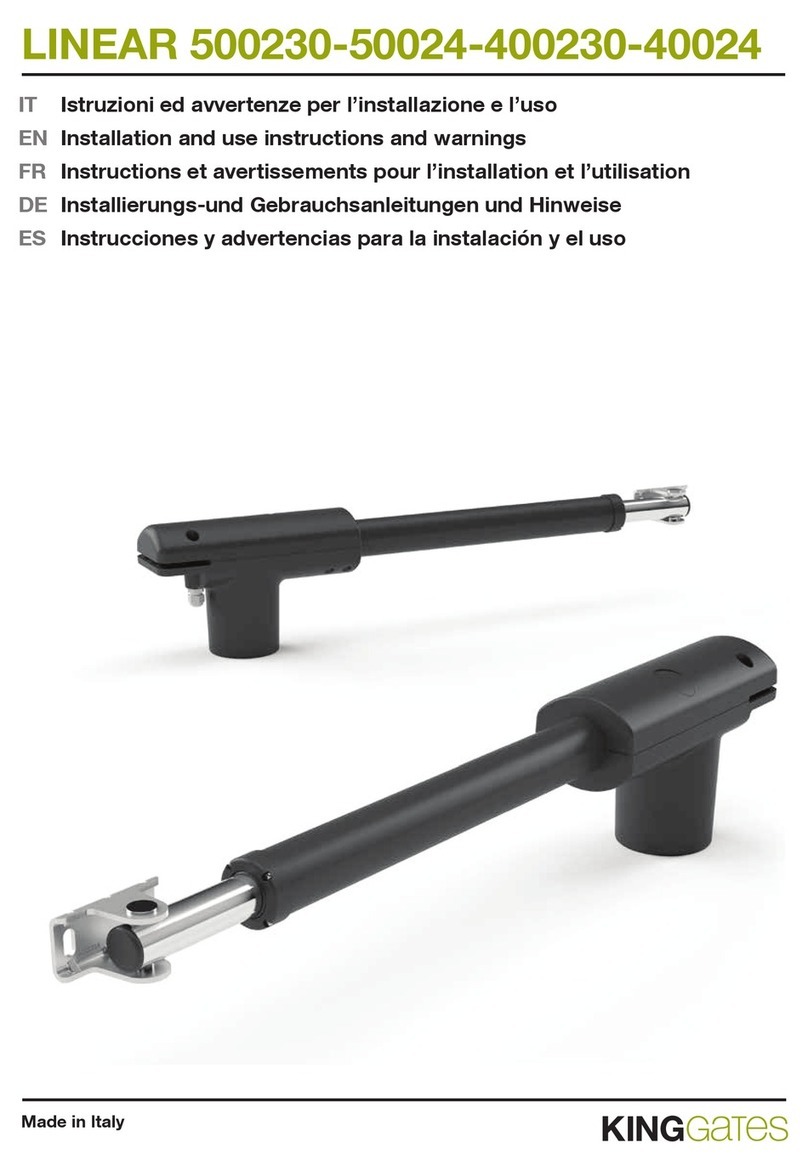
King gates
King gates LINEAR 500230 Installation and use instructions and warnings
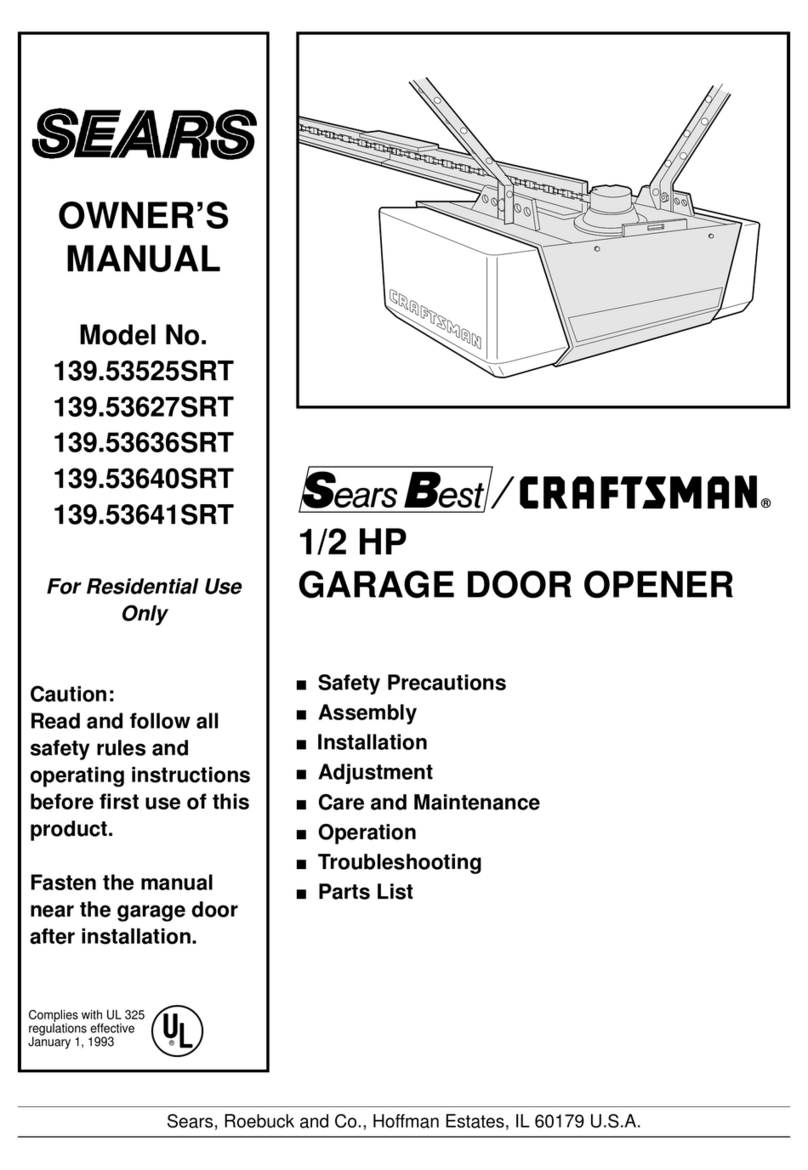
Craftsman
Craftsman 139.53525SRT owner's manual

Chamberlain
Chamberlain 1255GM owner's manual
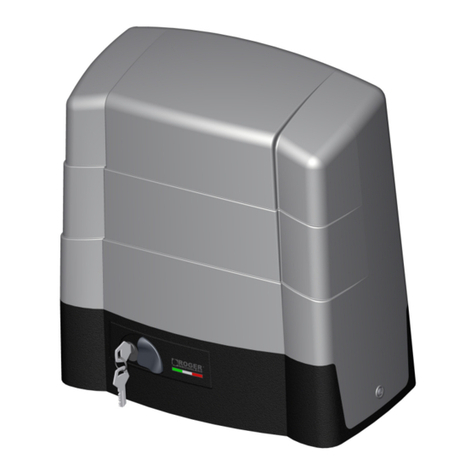
Roger
Roger BG30 Series INSTRUCTIONS AND RECOMMENDATIONS FOR THE INSTALLER
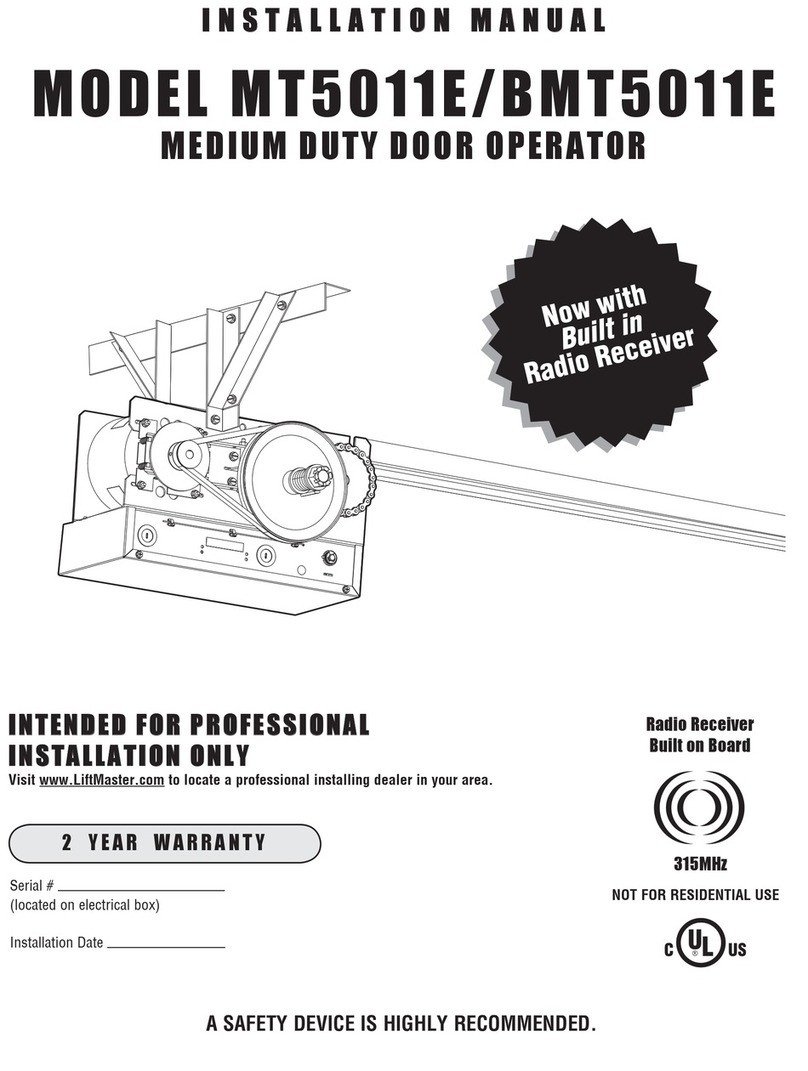
Chamberlain
Chamberlain MT installation manual
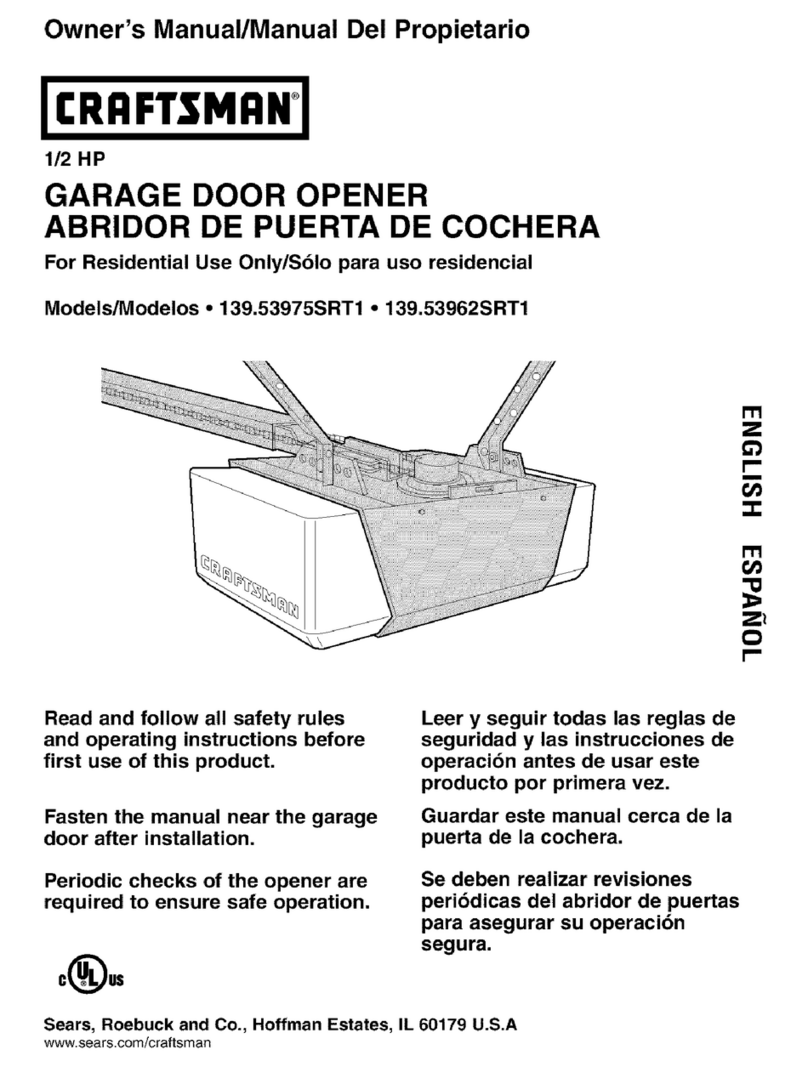
Craftsman
Craftsman 139.53962SRT1 owner's manual

SEA
SEA TAURUS RACK Series instruction manual
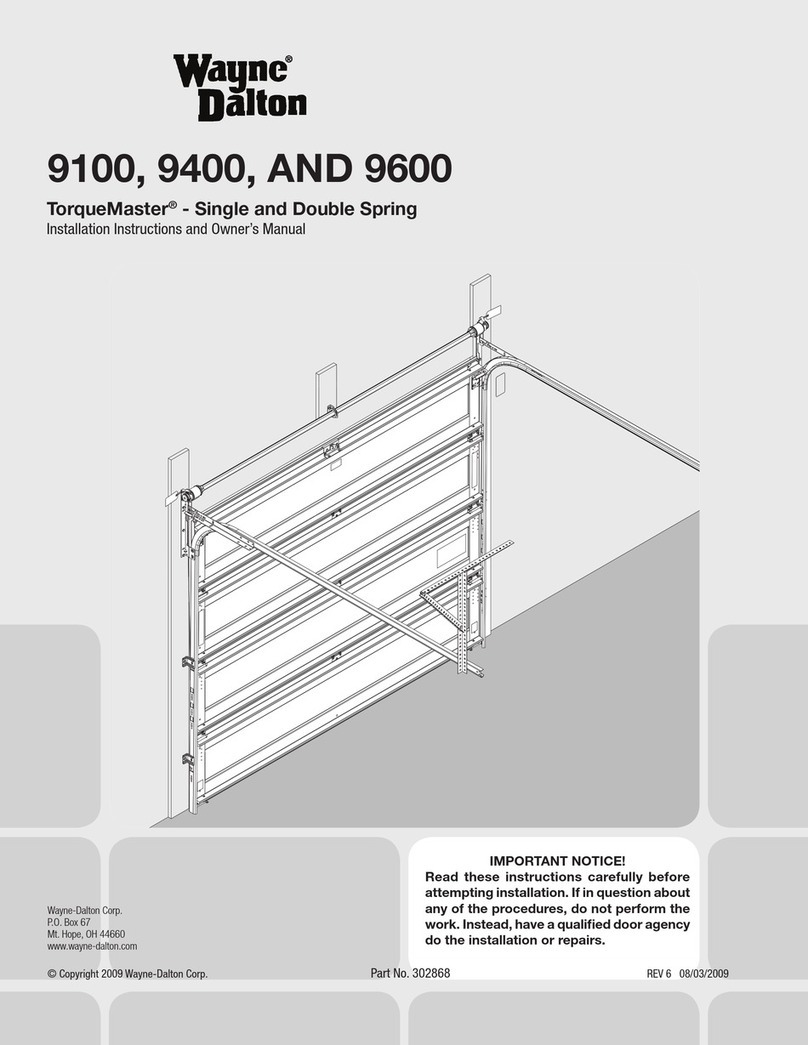
Waync Dalton
Waync Dalton 9100 Installation instructions and owner's manual
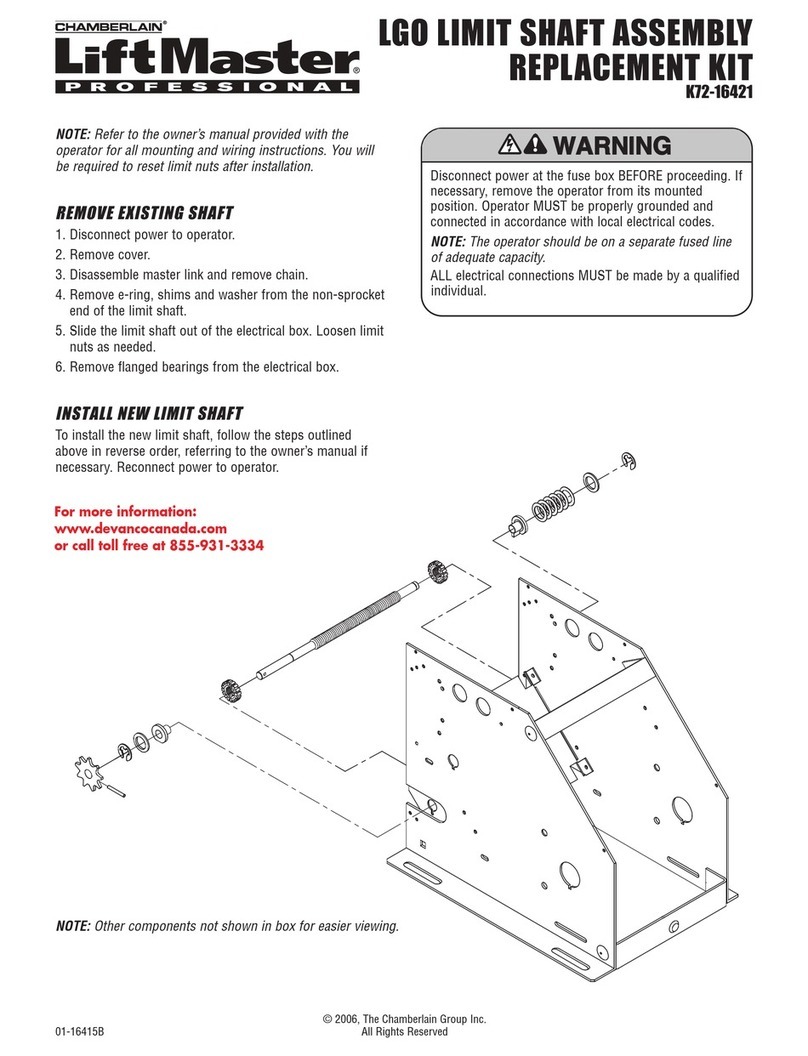
Chamberlain
Chamberlain K72-16421 owner's manual
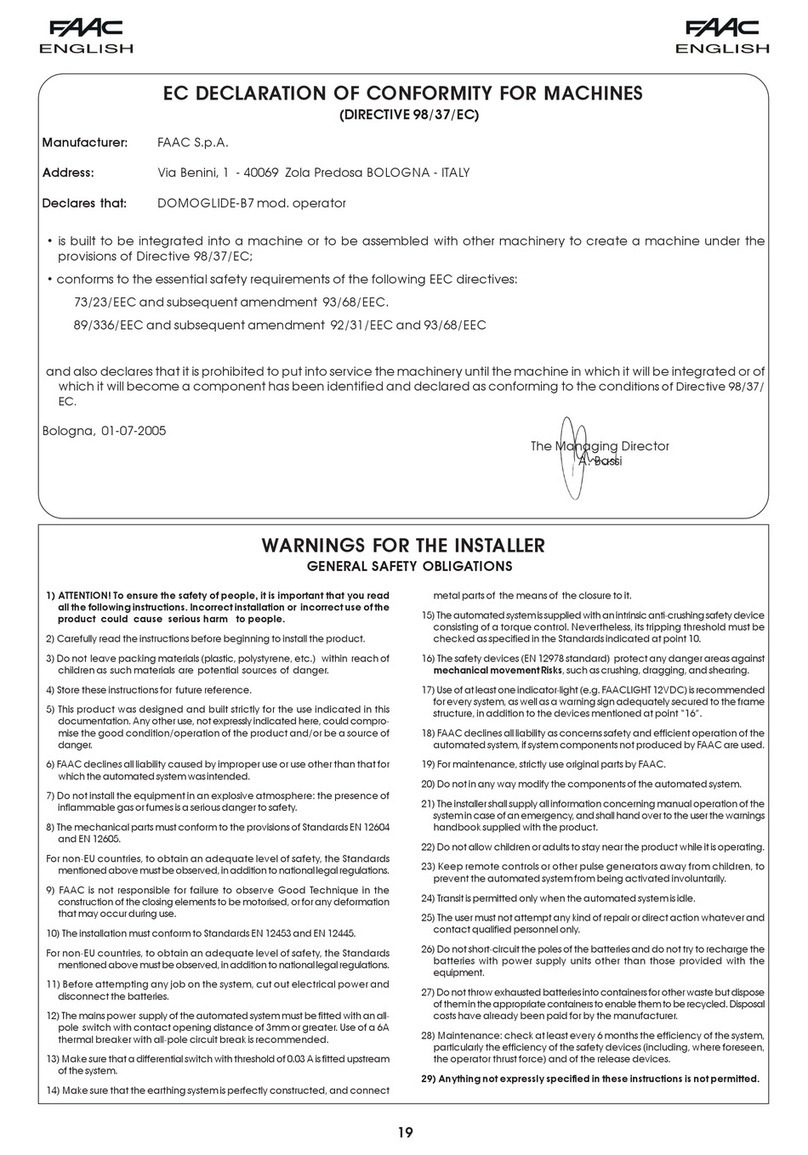
FAAC
FAAC DOMOGLIDE-B7 manual

Chamberlain
Chamberlain Whisper Drive Security+ HD900D owner's manual
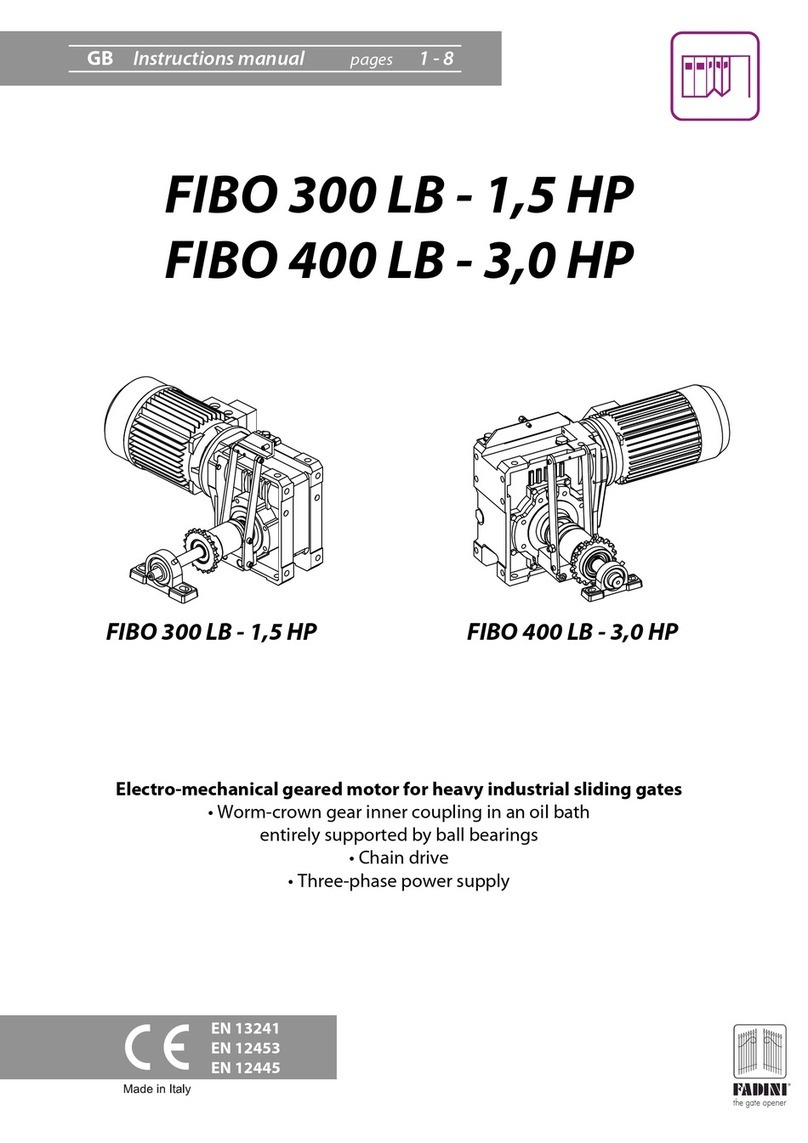
fadini
fadini FIBO 300 LB-1,5 HP instruction manual
